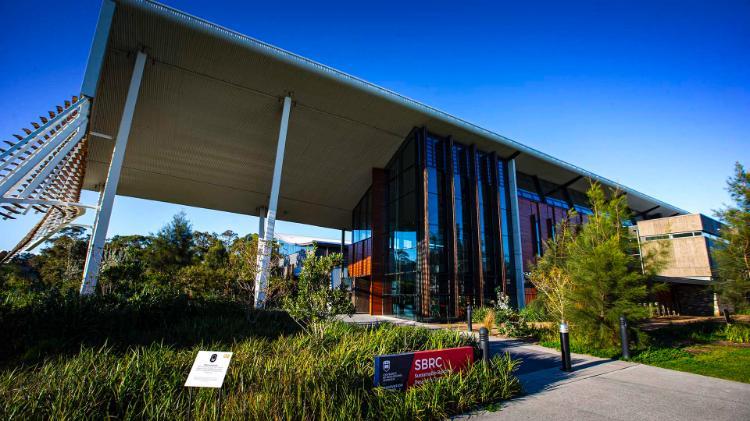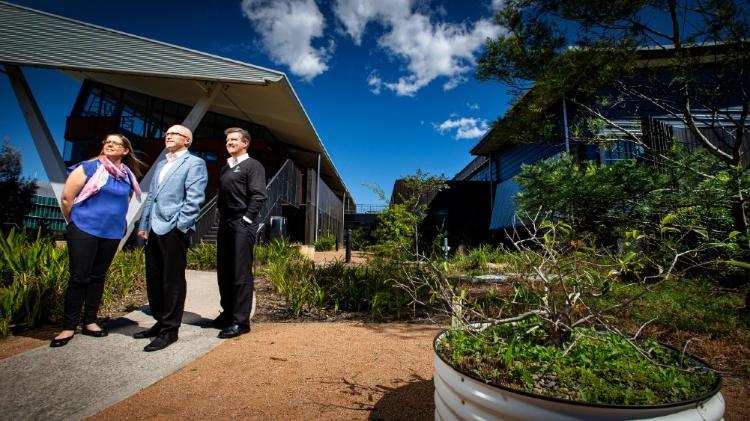[Music]:
[Speaker: Joe Agius – Design Director, Cox Architecture]: It is a building of its place. It’s very much informed by its’ landscape setting in the broad sense of the word. The escarpment, the ocean, the textures and the materials of the site. I'd like to see the building as being, in a sense or having grown from the site.
[Music]:
[Speaker: Professor Paul Cooper – Director, Sustainable Buildings Research Centre (SBRC)]: So, our vision for the Sustainable Buildings Research Centre from the start was something that was going to push the boundaries, something a building that we could look back on in 10 years time or longer and know that we really pushed the boundaries of sustainability. We wanted it to be net zero energy. We wanted it to be net zero water and we wanted it to be made of materials that were benign, very environmentally friendly.
[Music]:
[Speaker: Joe Agius – Design Director, Cox Architecture]: So the notion of brick alaj is essentially about making an object from found things. And our interpretation of that for this building was really using materials or a material palette that is essentially sourced locally as much as possible. They found and reused rail track, found and reused brick and found and reused timber, they are the principal materials for the envelope of the building.
There's a practical aspect to all of this as well. It allows the building to gracefully weather in place. It's not a building that requires a high degree of maintenance to be kept shining and new. We wanted to grow old gracefully and we want the building materials to register age and time. And the other aspect to sustainability is the two reforms to the building. The High Bay building, with its rolled curved roof, is shaped that way to facilitate natural ventilation from north to south, whereas the research building with its long wing shaped roof, with its very extensive shading on the north side and it's kick up to the south side is really about enabling cross ventilation but also controlling light in a very precise way and prohibiting glare, given the intensity of screen based activity. If you go into that office space now, I think you'll find that there'll be no lights turned on and you'll know that there's no blinds that have been retrofitted, and that's a really good measure of the quality of the daylighting within the space.
[Speaker: Michael Bradburn – Project Architect, Cox Architecture]: The predominant key challenge is we were aiming to achieve the Living Building Challenge for living building status, as the first Australian building to attempt to do this. We needed to meet a whole series of criteria, including eliminating chemicals that are on a particular red List, but also meeting any industry standards like the Forest Stewardship Council, FSC standard for timber.
The building itself is an experiment and will be tested on and retrofitted overtime as a core focus of this center. And there's a rooftop test area pacifically designed as somewhere that research test kit can be landed and plugged in and used in the building.
On the other side of the building here, we've got the first installation of building integrated photovoltaic technology that was developed with BlueScope. It's an example of a retrofitted detailing approach to this particular technology. That approach of plug and play also extends to the mechanical water system to input heated or cooled water from a source, for example, geothermal, and put it into the mechanical system where it's used by the building or a smart grid that simulates the grid that allows any generation source, so that the PV or wind or possibly even wave technology in the future to be plugged into the building and directed to any load source in the building.
[Speaker: Joe Agius – Design Director, Cox Architecture]: In terms of other favorite positive outcomes, the fact that the Urban Agricultural Garden is actually a living, thriving place, and the students and researchers actually do use it to grow food.
In terms of user comments etc., the thing that's most pleasing is that it works as a place to conduct meaningful research. It supports the research intent of the University. In terms of feedback from students, the fact that they just enjoy being there. They enjoy the ambience and the warm of the building. We strive to create a building and a place that has had an almost domestic quality about it.
[Speaker: Professor Paul Cooper – Director, Sustainable Buildings Research Centre (SBRC)]: So the Sustainable Buildings Research Centre building has been a tremendous asset to the university since we've been in occupation here in terms of attracting the attention of international students and top research students. But also it's a really nice place to work in and I think I speak for everyone who works here, it's a privilege to be in this space.
[Music]








